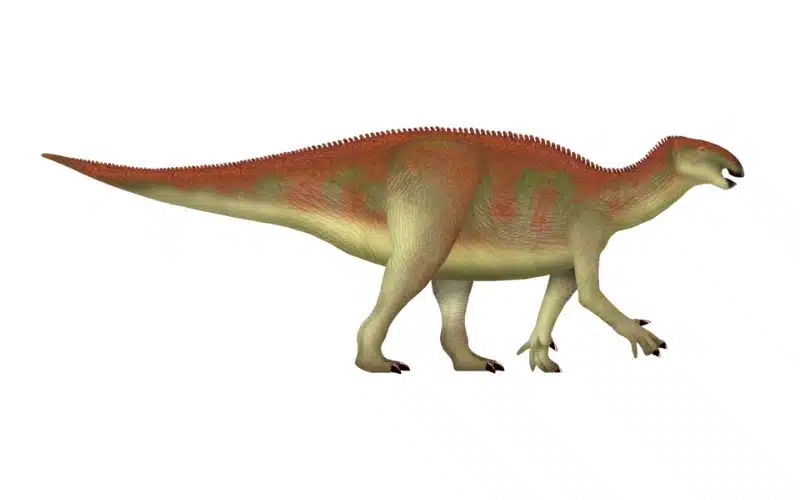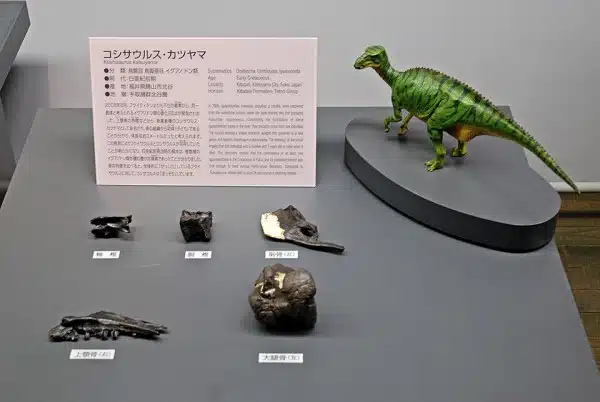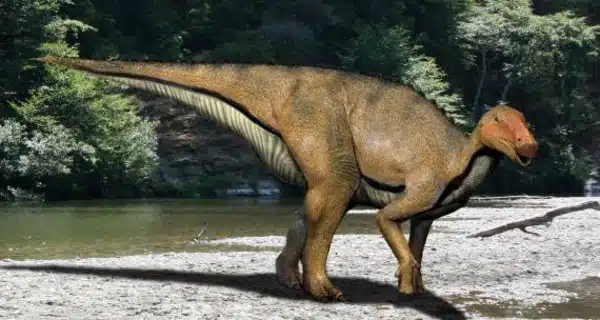In the lush floodplains of Early Cretaceous Japan, an unassuming herbivore made quiet strides beneath the ferns and cycads. This dinosaur, named Koshisaurus, was one of the region’s earliest representatives of a group that would eventually include the duck-billed giants of the Late Cretaceous.
Discovered in the Kitadani Formation of Fukui Prefecture, Koshisaurus katsuyama lived during the Aptian, approximately 113 million years ago. Its fossils reveal a primitive hadrosauroid with distinct dental and cranial features, suggesting a transitional position between earlier iguanodontians and the more derived forms that followed. As one of the few hadrosauroids known from Japan, it has become a key piece in the puzzle of Asian dinosaur evolution, marking both a geographic and evolutionary milestone.
Note: The phylogenetic analysis presented in the descriptive paper places this dinosaur in an unresolved polytomy with 34 other taxa. Despite several distinctive anatomical features, this lack of resolution makes it difficult to confidently establish the specimen as a new taxon. Caution is therefore warranted in accepting Koshisaurus katsuyama as a valid new taxon.
Koshisaurus Key Facts
| Keyword | Fact |
|---|---|
| Pronunciation | KOH-shee-SORE-us |
| Meaning of name | Koshi lizard |
| Group | Ornithopoda |
| Type Species | Koshisaurus katsuyama |
| Diet | Herbivore |
| When it Lived | 125 to 116 MYA |
| Period | Early Cretaceous |
| Epoch | Barremian to Aptian |
| Length | 11.5 feet |
| Height | 4.9 feet |
| Weight | 881.8 pounds |
| Mobility | Moved on two legs |
| First Discovery | Not specified |
| Described by | 2015 by Masateru Shibata & Yoichi Azuma |
| Holotype | FPDM-V9079 |
| Location of first find | Fukui Prefecture, Japan |
Koshisaurus Origins, Taxonomy and Timeline
The name Koshisaurus originates from cultural roots. Indeed, “Koshi” refers to the ancient Koshi no kuni, a historic province once encompassing parts of present-day Fukui Prefecture. The species name refers to the city where the holotype was found (the town is called Katsuyama).

Koshisaurus is an early diverging hadrosauroid, placing it within the broader group of Ornithopoda—bipedal herbivores that include the well-known Iguanodon and later hadrosaurids. As a more “basal” member of Hadrosauroidea, Koshisaurus katsuyama exhibits traits that are transitional between older iguanodontians and more advanced duck-billed dinosaurs. It is distinct from other ornithopods of the region, particularly Fukuisaurus, which is more basal and occupies a separate evolutionary branch.
Koshisaurus was found in the Kitadani Formation, which dates back the Barremian to the early Aptian (Early Cretaceous, roughly 125 to 116 Ma). This Formation has yielded several dinosaurs (including Fukuisaurus) and is an important window to understand the local Japanese fauna during the Cretaceous.
Discovery & Fossil Evidence
The holotype of Koshisaurus comes from the Kitadani Quarry close to the city of Katsuyama, within the fossil-rich Kitadani Formation. Although the exact year of the discovery hasn’t been detailed, the species was formally described in 2015 by paleontologists Masateru Shibata and Yoichi Azuma. The holotype, catalogued as FPDM-V9079, includes parts of the skull, vertebrae, pelvis, and limb bones.

The remains include the right maxilla (holotype), the centrum of the caudal-most dorsal vertebra, the proximal portion of the left pubis and the distal part of the left femur. They were uncovered from Bonebed IV of the formation, a layer known for its diversity of vertebrate fossils. Despite being incomplete, the fossil material was sufficient to identify unique traits that warranted the establishment of a new genus and species. Among these were particular features of the maxilla, pubis, and femur, which set it apart from closely related taxa.
Importantly, the skull material includes a maxilla with an antorbital fossa—an indentation not typically found in more derived hadrosauroids. This, along with multiple ridges on the maxillary teeth, helped solidify its placement as a basal member of the group and hinted at functional adaptations for early herbivorous feeding strategies.
Koshisaurus Size and Description
Short description of Koshisaurus
This dinosaur had a lightly built body with possibly long hindlimbs, suggesting efficient bipedal locomotion. Although no cervical vertebrae were retrieved, its neck was likely moderately long, resulting in a relatively small, elongated skull characteristic of early hadrosauroids. The vertebral column, as preserved, hints at a flexible spine, which may have assisted in quick directional changes while moving through dense vegetation.
The limbs were robust yet adapted for speed rather than power. Like its relatives, its arms were likely much shorter than its legs, affirming a primary reliance on bipedal movement. Its tail, likely used for balance, extended behind in a straight line, a common feature among ornithopods that enabled stable running. Skin impressions are unknown, but comparisons with related species suggest scaly skin with no indication of feathers.
Size and Weight of Type Species
Koshisaurus katsuyama was likely 11.5 feet in length and 4.9 feet tall at the hips. Its body weight was approximately 881.8 pounds. While smaller than later hadrosaurids, it was still a substantial animal for its time, particularly within the insular environment of Japan’s Early Cretaceous ecosystems.
These dimensions make it larger than many contemporary iguanodontians of similar age in the region. Yet, it remains well below the size of giants like Iguanodon or the more derived hadrosaurids that would come later in the Cretaceous. Its relatively light frame and moderate build suggest it relied more on agility than bulk for survival.
The Dinosaur in Detail
One of the key traits that distinguishes this dinosaur is the presence of an antorbital fossa on the maxilla (between two of the lacrimal processes) an ancestral feature not found in more advanced hadrosauroids. This structural groove may have served to lighten the skull while maintaining strength, or it might have been a remnant of air sac systems used in respiration or thermoregulation.
The maxillary teeth of Koshisaurus (a total of 19 alveoli, but only 13 teeth preserved) display three subsidiary ridges on their labial surfaces that align mesial to the primary ridge. This is an unusual trait shared with a few other basal hadrosauroids like Equijubus and Xuwulong, but absent from Fukuisaurus (which has only one subsidiary ridge). These ridges could have contributed to more effective plant processing, hinting at a diet involving fibrous vegetation. This specialization indicates a move toward the complex dental batteries seen in later hadrosaurids, though it had not yet achieved that level of intricacy.
Phylogenetic study done for the initial description of Koshisaurus places it within Hadrosauroidea, making it more derived than Fukuisaurus, but still at the base of the clade. However, the phylogeny presented in the paper is poorly resolved, with Koshisaurus placing in an unresolved position with 34 other taxa. Caution is advised regarding the classification of this new dino.
Interesting Points about Koshisaurus
- Koshisaurus is one of the earliest known hadrosauroids discovered in Japan, offering insight into the early stages of this group’s evolution. It’s one of the few dino discovered in Japan.
- It is more derived than its contemporary Fukuisaurus, indicating a progression toward more advanced hadrosauroid characteristics.
- The teeth display multiple subsidiary ridges, suggesting possible early adaptations for processing fibrous plant material.
- It retained the ancestral antorbital fossa on the maxilla, a primitive feature absent in more evolved hadrosauroids.
- Fossils were recovered from the Kitadani Formation, one of Japan’s most productive and scientifically important dinosaur fossil sites.
Contemporary Dinosaurs
All dinosaurs presented in this section come from the Kitadani Formation, which yielded the fossils of Koshisaurus. This emphasises the fossil richness of the locality.
Roaming the same ancient landscape as this early hadrosauroid was Fukuiraptor, a nimble megaraptoran (Theropoda) thought to be a medium-sized predator. This dino was also found in the Kitadani quarry. With sharp claws and a lightly built frame, it was likely well-adapted for chasing down small prey. While it’s uncertain whether it actively hunted herbivores like Koshisaurus, juveniles or sick individuals may have fallen within its range of opportunistic targets, adding a layer of predator-prey tension to the region’s ecological web.

Another plant-eater sharing this environment was Fukuisaurus, a more primitive ornithopod (also from the Kitadani Formation). Although both dinosaur species were herbivores, their anatomical differences suggest they occupied subtly different niches. With less derived jaw mechanics and dental structure, Fukuisaurus may have fed on different types of vegetation or foraged in slightly varied habitats, reducing direct competition.
Towering above them was Fukuititan (again, from the Kitadani Formation), a large sauropod that added a colossal presence to the floodplain. Its massive frame and long neck allowed it to browse high above the ground, far beyond the reach of smaller bipeds. Despite the enormous size gap, these two herbivores could coexist peacefully, each feeding at different levels of the forest.
Also part of this ancient Japanese ecosystem was Fukuivenator, a small but curious theropod with an unusual blend of features that suggest a diet potentially more omnivorous than strictly carnivorous. Agile and possibly feathered, it likely darted between undergrowth and open space in search of insects, small vertebrates, or even plant material. Though it didn’t pose much threat to Koshisaurus, its presence further highlights the ecological complexity of this Cretaceous environment, where each species filled a distinct role in a finely balanced web of life.
Koshisaurus in its Natural Habitat
The environment where this dinosaur lived was a lowland floodplain dominated by river channels, moist forests, and fern-covered clearings. During the Aptian, Japan’s landmass was a series of islands and coastal plains, making habitats more insular and ecologically distinct. This type of landscape favored adaptable herbivores that could forage on a range of plants from ground-level ferns to taller shrubs.
As a herbivore, Koshisaurus likely browsed selectively on soft vegetation, using its complex teeth to slice through tough plant fibers. Its bipedal gait made it swift and agile, likely an advantage when evading predators or navigating dense undergrowth. There’s no evidence yet of pack behavior, but it may have foraged in small groups like many other ornithopods.
Its senses were probably well-developed, especially sight and hearing, which would have aided in detecting threats. Over time, the presence of species like Koshisaurus helped shape the landscape by influencing vegetation growth and creating feeding trails—subtle but meaningful ecological impacts that echo in the fossil record.
Frequently Asked Questions
Koshisaurus was a basal hadrosauroid, an early member of the group that includes duck-billed dinosaurs.
It lived during the Barremian to Aptian Stage of the Early Cretaceous, between 125 to 116 million years ago.
Fossils were uncovered in the Kitadani Formation, Fukui Prefecture, on Honshu Island, Japan.
As an herbivore, it fed on soft vegetation, likely including ferns, cycads, and other ground-level plants.
It measured around 11.5 feet long, stood 4.9 feet tall, and weighed approximately 881.8 pounds.
It was formally described in 2015 by Masateru Shibata and Yoichi Azuma.
Sources
The information in this article is based on various sources, drawing on scientific research, fossil evidence, and expert analysis. The aim is to provide a comprehensive and accurate overview of Koshisaurus. However, please be aware that our understanding of dinosaurs and their world is constantly evolving as new discoveries are made.
This article was last fact checked: Joey Arboleda, 05-06-2025
Featured Image Credit: UnexpectedDinoLesson, CC BY-SA 4.0, via Wikimedia Commons
